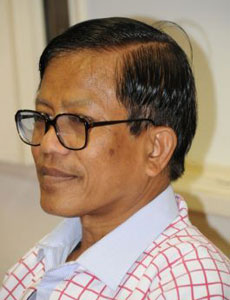(Interview) - The newly formed United Nationalities Federal Council (UNFC) is made up of 12 ethnic groups. In 2010, six armed ethnic groups formed an alliance called the Committee for the Emergence of a Federal Union (CEFU). Its membership was extended to 12 organizations in February 2011, and the CEFU was abolished to reform as the UNFC. On May 12, the alliance was reformed comprising six dedicated organizations and six associated member organizations, according to Naing Han Tha, the general secretary of the New Mon State Party and secretary of the alliance. Mizzima reporter Ko Wild talked with Naing Han Tha about the new organization and its goals.

Question: Which organizations attended the meeting conducted by the United Nationalities Federal Council (UNFC) from May 9 to 12?
Answer: Nine out of the 12 member organizations attended the meeting. This was only an interim arrangement. That’s why some member organizations did not attend. Soon, we will hold an all-inclusive meeting. All six dedicated organizations of the UNFC attended the meeting. Moreover, the Kachin National Organization (KNO), Pa-O National Liberation Organization (PNLO), and the National United Party of Arakan (NUPA) also attended the meeting. We invited the NUPA as the organization which represents Arakan State.
Q: How was the structure of the UNFC reorganized?
A: The UNFC comprises dedicated member organizations and associated member organizations. In accordance with our criterion, every dedicated member organization must have a strong political party, well-armed troops, a control area and a large number of supporters. However, we will cooperate with associated member organizations who fail to meet the criteria.
Q: What is your policy based on?
A: The reformation of the UNFC was based on the criterion that every dedicated member organization needs to meet key requirements. Our cooperative work will be effective if we have a strong political force and well-armed troops. Some organizations could not meet the criterion. We are just trying to gather together strong organizations to create a powerful alliance.
Q: In February, the membership was extended to what organizations?
A: A total of 12 organizations: the Kachin Independence Organization (KIO); Kachin National Organization (KNO); Karen National Union (KNU); New Mon State Party (NMSP); Karenni National Progressive Party (KNPP); Palaung State Liberation Front (PSLF); Lahu Democratic Union (LDU); National United Party of Arakan (NUPA); Shan State Progressive Party (SSPP); Pa-O National Liberation Organization (PNLO); Wa National Organization (WNO); and the Chin National Front (CNF).
Q: Who are the six dedicated members?
A: The six dedicated members are the KNU, NMSP, KNPP, KIO, SSPP and the CNF. The rest are associated member organizations.
Q: Can you describe the leadership structure of the UNFC?
A: We have the UNFC Council and the central executive committee. Every dedicated member organization had to choose representatives (at least two, at most four) for the UNFC Council. Those representatives are members of the UNFC Council. Presently, we have 22 members of the UNFC council. Nine of them have been elected as central executive committee members.
Q: What are the roles of the representatives from the associated member organizations of the UNFC in the leadership structure?
A: In the meeting held in February, they named one or two representatives. But the representatives from the associated member organizations cannot be dedicated central executive committee members. We will hold a meeting very soon. At that time, the representatives from the associated member organizations will attend the meeting. Although they are not on the list of the 22 central executive committee members, we recognize them.
Q: We heard that the SSPP will represent all of Shan State. Is that true?
A: The SSPP needs to talk with other groups in Shan State about this issue. They need to discuss how they can cooperate.
Q: Some people say the UNFC will set up a Union Army and KNU General Mutu Saypo will lead it. Is that true?
A: Our Union Army comprises armed groups from all member organizations but it is not a separate army. The military wing is to be headed by Genera Mutu Saypo. Every member organization can name their armed group commander in chief or deputy commander in chief as a representative to the UNFC’s military wing. After this meeting, we can successfully implement this idea.
Q: How many troops will be under the UNFC Union Army?
A: It’s difficult to estimate. We also have reserve troops. I think we have more than several thousand.
Q: Your group has formed an armed alliance. How about political dialogue as a way to solve problems instead of armed might?
A: We’re always open for dialogue. Armed conflict cannot solve all of the country’s problems. Political dialogue is the best solution. Anyway, war is a continuation of politics. The former junta can’t accept it. If we have to choose a military option, our aim is to protect our people and our land.
Q: Rumours were circulating that the SSPP had resigned from the UNFC. Was the SSPP part of the Committee for the Emergence of a Federal Union (CEFU) that was the precursor of UNFC?
A: Yes, it was officially a part of CEFU. I don’t know how the rumours spread. The SSPP also said that they did not say it, and they don’t know how the rumours circulated.



